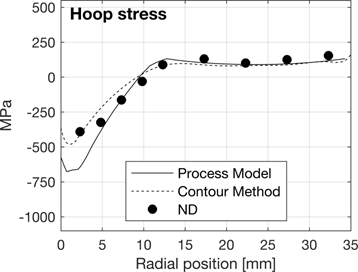Hill Engineering recently co-authored presentations at the TMS 2023 Annual Meeting & Exhibition in San Diego, CA on March 19th through the 23rd. The TMS Annual Meeting & Exhibition brings together more than 4,000 engineers, scientists, business leaders, and other professionals in the minerals, metals, and materials fields for a comprehensive, cross-disciplinary exchange of technical knowledge. The abstracts for the presentations that we co-authored are copied below.
Determination of Residual Stress and Strain Fields during Cold Expansion Processing Using Complementary Diffraction Techniques
Synchrotron X-ray and time-of-flight neutron diffraction measurements are used to determine elastic residual strain and stress fields in the vicinity of geometrically large holes in 7050-T7451 aluminum plate samples caused by cold expansion (Cx) processing. The measurements are relevant because Cx is widely used in the aircraft industry to improve the fatigue resistance of critical components containing fastener holes. Recent model development reveals a large discrepancy between computed and measured residual stress fields. The Los Alamos SMARTS and Cornell FAST diffractometers are used to determine the residual stress and strain fields in partially (50%) and fully (100%) processed samples. Consistent strain trends are observed in both samples for the two types of measurements, with the datasets being complementary: neutrons offering determination of stress, and X-rays revealing fine spatial variations of strain. Together these data provide opportunities for improving process models of Cx.
Bulk Residual Stress and Strain Measurements Near Geometrically Large Holes for Improving Cold Expansion Process Models
We report on a series of measurements of residual stress and residual strain near large cold expanded holes. The work was undertaken to improve engineering models of the hole cold expansion (Cx) process and support more effective use of compressive residual stress treatments that extend fatigue life and/or inspection periods. Measurements were made in samples with a 25.4 mm thickness and a centered 25.4 mm hole, so the features are large relative to typical applications. Measurements use a complement of diverse techniques: the contour method, time-of-flight neutron diffraction (LANL SMARTS instrument), and EDXRD (CHESS FAST instrument). Comparisons of data show all techniques in agreement. Comparisons of data to outputs from a process simulation are consistent with systematic discrepancies reported in prior publications that have significant effects on forecasts of Cx fatigue benefits. The measurement data therefore provide an engineering basis for making improvements to the process simulation.
If these topics are of interest to you, please contact us for additional information.
